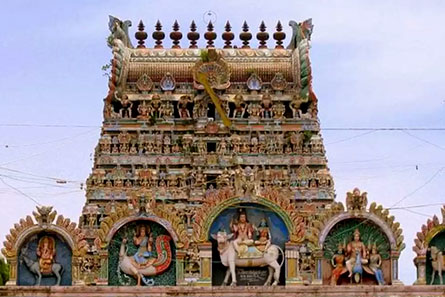Vaitheeswaran Koil Temple Architecture (Temple of Lord Vaidyanath)
The temple is located between Sirkali to Mayiladuthurai State Highway. Frequent bus services are operated by Tamil Nadu government. There is a Railway station which is located between Chennai to Mayiladuthurai railway road. Karaikal is the nearest proposal airport located around 40 kilometer from temple.
The temple has a five-tiered gopuram (temple tower), two inner gopurams and large precincts. The central shrine is that of Lord Vaidyanath present as lingam in the inner most sanctum. The first precinct around the sanctum has the metal image of Subramanya, worshipped here as Muthukumara Swamy.
The other metal images in the sanctum are of Nataraja, Somaskanda, Angaraka and stone sculptures of Durga, Dakshina moorthy, Surya (Sun god), Jatayu, Vedas, Sampati. The shrine of Thaiyalnayaki in the second precinct facing south houses the image of Thiyalnayagi sported in standing posture with the medicinal oil to cure the diseases.
Lord Dhanvantari & Angaraka
The large precinct also has a small shrine to Dhanvantari and shrine of Angaraka in stone sculpture. The southern gateway from this precinct leads to the temple tank and directly faces the Thaiyalnayaki shrine. The Sthala Vriksha (temple tree) is margosa (Azadirachta indica, neem tree), believed to possesses medicinal properties, is present near the eastern gateway.
The eastern gateway also has the shrine of Adi (original) temple that has a smaller replica of the main shrines. There is a fine metal image of Gangavisarjanar inside the temple. The shrine of Angaragan (Mars) is present near the Eastern gateway in the third precinct.
Healing properties of Vaitheeswaran Koil
The Siddsmirta tank, near the southern gateway of the temple complex, contains medicinal clay and along with the holy ash, this medicine, called Thiruchandu Urundai is said to cure many diseases of the devotees who seek it. Another preparation made to serve as a medication is the mixture of Chandan powder (Sandalwood powder) and Saffron blessed by the Lord himself.
Apart from that, a mixture of salt, pepper and jaggery are offered near the Siddsmirta tank to cure one’s diseases. At times, devotees purchase silver-plated images of body parts that are afflicted by various ailments and put them into the Hundi (A large container for offerings) to be cured by those ailments. The essence of the neem leaves and the neem barks derived from the Sthala Vriksha (Temple Tree) of the temple complex is also served to the devotees as a medicine.

